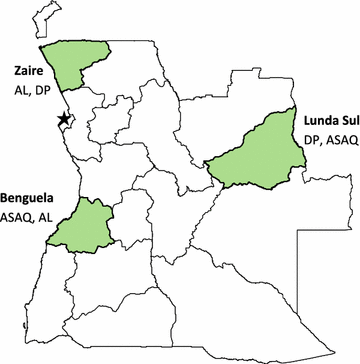Efficacy of artemether-lumefantrine, artesunate-amodiaquine, and dihydroartemisinin-piperaquine for treatment of uncomplicated Plasmodium falciparum malaria in Angola, 2015
- PMID: 28153004
- PMCID: PMC5290657
- DOI: 10.1186/s12936-017-1712-4
Efficacy of artemether-lumefantrine, artesunate-amodiaquine, and dihydroartemisinin-piperaquine for treatment of uncomplicated Plasmodium falciparum malaria in Angola, 2015
Abstract
Background: Recent anti-malarial resistance monitoring in Angola has shown efficacy of artemether-lumefantrine (AL) in certain sites approaching the key 90% lower limit of efficacy recommended for artemisinin-based combination therapy. In addition, a controversial case of malaria unresponsive to artemisinins was reported in a patient infected in Lunda Sul Province in 2013.
Methods: During January-June 2015, investigators monitored the clinical and parasitological response of children with uncomplicated Plasmodium falciparum infection treated with AL, artesunate-amodiaquine (ASAQ), or dihydroartemisinin-piperaquine (DP). The study comprised two treatment arms in each of three provinces: Benguela (AL, ASAQ), Zaire (AL, DP), and Lunda Sul (ASAQ, DP). Samples from treatment failures were analysed for molecular markers of resistance for artemisinin (K13) and lumefantrine (pfmdr1).
Results: A total of 467 children reached a study endpoint. Fifty-four treatment failures were observed: four early treatment failures, 40 re-infections and ten recrudescences. Excluding re-infections, the 28-day microsatellite-corrected efficacy was 96.3% (95% CI 91-100) for AL in Benguela, 99.9% (95-100) for ASAQ in Benguela, 88.1% (81-95) for AL in Zaire, and 100% for ASAQ in Lunda Sul. For DP, the 42-day corrected efficacy was 98.8% (96-100) in Zaire and 100% in Lunda Sul. All treatment failures were wild type for K13, but all AL treatment failures had pfmdr1 haplotypes associated with decreased lumefantrine susceptibility.
Conclusions: No evidence was found to corroborate the specific allegation of artemisinin resistance in Lunda Sul. The efficacy below 90% of AL in Zaire matches findings from 2013 from the same site. Further monitoring, particularly including measurement of lumefantrine blood levels, is recommended.
Figures
References
-
- World Health Organization . Guidelines for the treatment of malaria. Geneva: World Health Organization; 2012.
-
- World Health Organization . World malaria report. Geneva: World Health Organization; 2014.
MeSH terms
Substances
Grants and funding
LinkOut - more resources
Full Text Sources
Other Literature Sources
Research Materials


